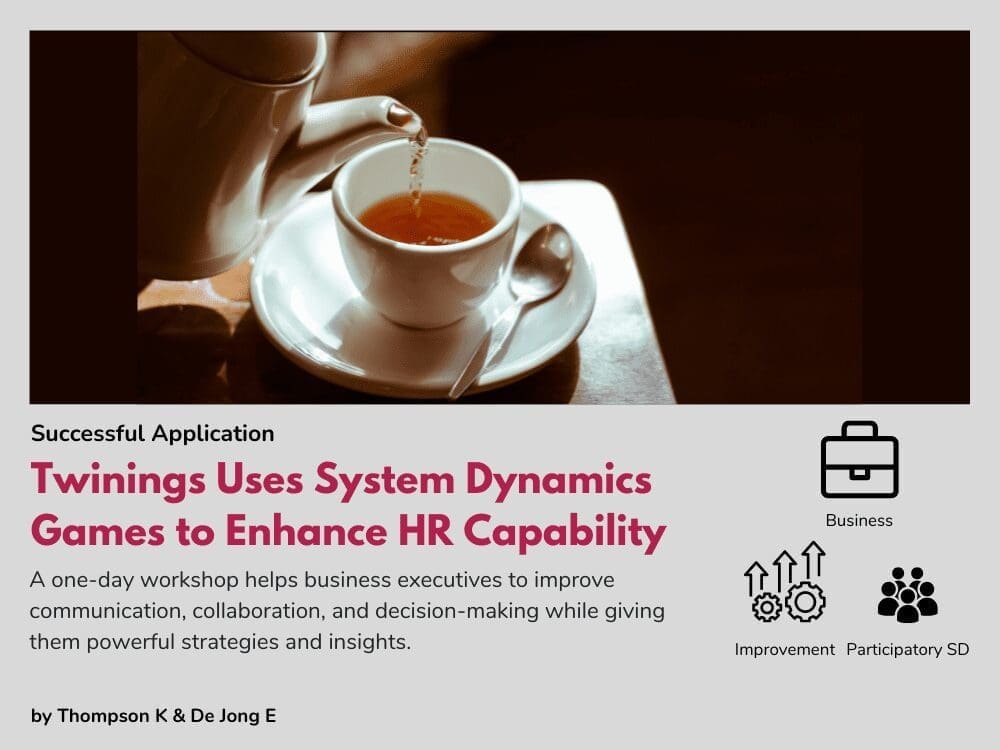Twinings Uses System Dynamics Games to Enhance HR Capability
“Realistic simulation is a powerful approach to building capability. The business simulation developed [by Dashboard Simulations and Lane4] gave [Twinings staff] an experience that called for them to develop and deploy competitive strateg[ies]. People learned a lot from the experience, and because [the experience] is their [own], the transfer to the workplace was easy. The same business simulation could be used over and over again with different groups within the company so the return on investment has been exceptionally good.”―Simon Brocket, International Human Resources Director, Twinings
The Goal
Twinings is a leading global brand in the hot beverages market and offers a range of premium teas and malt beverages. In an effort to enhance the services offered to business partners, Simon Brocket, International Human Resources Director at Twinings, challenged Ken Thompson, of Dashboard Simulations, and Austin Swain, of Lane4, to design a business game that would help Twinings Human Resources (HR) staff understand the challenges of operating a country level business unit. The training sessions would be run over the course of a single day, and thus the insights had to be communicated in an engaging, authentic, and succinct manner. With that in mind, Ken and Austin chose System Dynamics to the power the simulator.
The Challenges
Historically Twinings business units are confronted with several challenges. In a series of interviews and workshops Ken and Austin worked with Simon and other Twinings subject matter experts to document their mental models and identify the most important challenges. Seven were selected for the simulator:
- Price vs. demand
- Reacting to the market vs. bucking the market
- New customers vs. existing customers
- Value chain vs. organizational health
- Leading indicators vs. lagging indicators
- Your strategy vs the unexpected
- Me vs. us Working in an executive team
The Simulator
As business units address these challenges the decisions they make ultimately affect customer loyalty as measured by consumption. The System Dynamics model at the core of the simulator represents this using stocks and flows as shown in Figure 1 below:
 Figure 1: Model overview
Figure 1: Model overview
In this model, customers move from stock to stock via the blue flow arrows. As customers progress from left to right, they consume more products leading to higher revenues. At each stage consumers can also choose to leave, hence the goal of the game is to make decisions which:
- attract new customers, turn them into regular consumers and ultimately vocal fans
- prevent customers from moving to lower levels of consumption or switching to competing products altogether.
Diving In…
During the daylong session, HR staff were organized into groups representing country level business units. Twice during each simulated year, the teams were given the opportunity to review results and make decisions for the upcoming period. At the end of each year the business units would present their results, insights, and plans for the following year to a senior Twinings executive acting as Group CEO.
As the game progressed teams explored each of the seven challenges; identifying insights and highlighting new options and strategies. Here are a few of the challenges they experienced.
Leading Indicators vs. Lagging Indicators
As prior decisions played out in the model, several metrics were reported on the decision board shown in Figure 2 below.
 Figure 2: Decision board
Figure 2: Decision board
Leading non-financial indicators like growth rate and lagging financial resultswere identified and discussed. As a result, HR staff gained a personal understanding of the information country level business units have to assess progress and make decisions, and how those decisions can affect future results.
Your Strategy vs. the Unexpected
With the start of every round the facilitators would announce market updates such as “a key competitor has changed their prices,” or “There is a shortage of raw materials” and tweak the model accordingly. With this new information and the metrics from their individual decision boards the business units were then faced with the decision: “Do we keep to the original plan or adjust to the new market conditions?” Teams made their decisions independently and the simulation moved forward. As the results came in the teams learned if the decision was wise, they discussed insights and planned changes.
Me vs. Us ‐‐ Working in an Executive Team
Each business unit, as in the real world, was comprised of several members that formed an executive team for that region. Over the course of the daylong session, critical skills of leadership, communication, collaboration, and decision making under pressure were tested and improved and the concept of collective responsibility was deeply reinforced.
The Impact
To date, the game has been run for eighteen different groups at Twinings, with very positive feedback. Staff have come away with personal exposure to the challenges facing the business units they serve, resulting in strategies and insights to serve them better.
Do you want to know more?
- High performance leadership/decisions: business game research findings (May 2013)
- Contact modelers Ken Thompson, Eline De Jong
OTHER SUCCESSFUL APPLICATIONS
Solving Bottlenecks in Dairy Production Facilities with System Dynamics
Solving Bottlenecks in Dairy Production Facilities with System Dynamics EXECUTIVE Summary FrieslandCampina faced potential bottlenecks in production due to the merging of two factories. They hired SD&Co which employed system dynamics simulation models to predict...
A Design Value Calculator: A System Dynamics Boardgame
A Design Value Calculator: A System Dynamics Boardgame EXECUTIVE Summary Product design is a specific form of complex innovation that touches all areas of an organization’s management. While entrepreneurs recognise the value of design, they often tend to focus...
The World Bank Uses System Dynamics to Identify Root Causes of Poverty
The World Bank Uses System Dynamics to Identify Root Causes of Poverty EXECUTIVE Summary Madagascar has one of the highest poverty rates in the world. In 2022, an astonishingly three out of every four people in Madagascar lived below the poverty line. Poverty has...
Upcoming Events

How Did En-ROADS Get 755,000 users? Lessons on Modeling, Interface Design, and Facilitation
May, 8 at 11 am NY | 4 pm London | 11 pm Beijing | Time Converter How Did En-ROADS Get 755,000 Users? Lessons on Modeling, Interface Design, and Facilitation In this participatory webinar, Drew Jones of Climate Interactive will share insights on how to create a System...
Recent Posts
Society Governance Updates
Society Governance Updates Welcome, Allyson! New President Allyson Beall King joined the Policy Council as our 2024 President. Her primary role is as director of the Washington State University School of the Environment, which focuses on regional ecologies and our...
Call for Presenters: Seminar Series
Call for Presenters: Seminar Series We at the System Dynamics Society are continually seeking vibrant and knowledgeable presenters for our ongoing Seminar Series. As we unfold the calendar, there’s always a place for more insights, experiences, and expertise to enrich...
Honoring Excellence: A Glimpse into the Awards of the International System Dynamics Conference
Honoring Excellence: A Glimpse into the Awards of the International System Dynamics Conference The International System Dynamics Conference brings together experts, practitioners, and students to exchange ideas, showcase real-world applications, and celebrate...
Join us
OTHER SUCCESSFUL APPLICATIONS
Solving Bottlenecks in Dairy Production Facilities with System Dynamics
Solving Bottlenecks in Dairy Production Facilities with System Dynamics EXECUTIVE Summary FrieslandCampina faced potential bottlenecks in production due to the merging of two factories. They hired SD&Co which employed system dynamics simulation models to predict...
A Design Value Calculator: A System Dynamics Boardgame
A Design Value Calculator: A System Dynamics Boardgame EXECUTIVE Summary Product design is a specific form of complex innovation that touches all areas of an organization’s management. While entrepreneurs recognise the value of design, they often tend to focus...
The World Bank Uses System Dynamics to Identify Root Causes of Poverty
The World Bank Uses System Dynamics to Identify Root Causes of Poverty EXECUTIVE Summary Madagascar has one of the highest poverty rates in the world. In 2022, an astonishingly three out of every four people in Madagascar lived below the poverty line. Poverty has...
Recent Posts
Society Governance Updates
Society Governance Updates Welcome, Allyson! New President Allyson Beall King joined the Policy Council as our 2024 President. Her primary role is as director of the Washington State University School of the Environment, which focuses on regional ecologies and our...
Call for Presenters: Seminar Series
Call for Presenters: Seminar Series We at the System Dynamics Society are continually seeking vibrant and knowledgeable presenters for our ongoing Seminar Series. As we unfold the calendar, there’s always a place for more insights, experiences, and expertise to enrich...
Honoring Excellence: A Glimpse into the Awards of the International System Dynamics Conference
Honoring Excellence: A Glimpse into the Awards of the International System Dynamics Conference The International System Dynamics Conference brings together experts, practitioners, and students to exchange ideas, showcase real-world applications, and celebrate...
Upcoming Events

How Did En-ROADS Get 755,000 users? Lessons on Modeling, Interface Design, and Facilitation
May, 8 at 11 am NY | 4 pm London | 11 pm Beijing | Time Converter How Did En-ROADS Get 755,000 Users? Lessons on Modeling, Interface Design, and Facilitation In this participatory webinar, Drew Jones of Climate Interactive will share insights on how to create a System...


